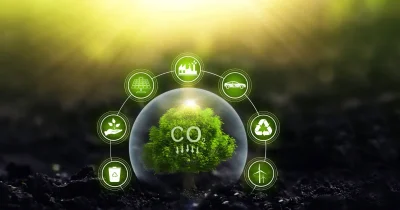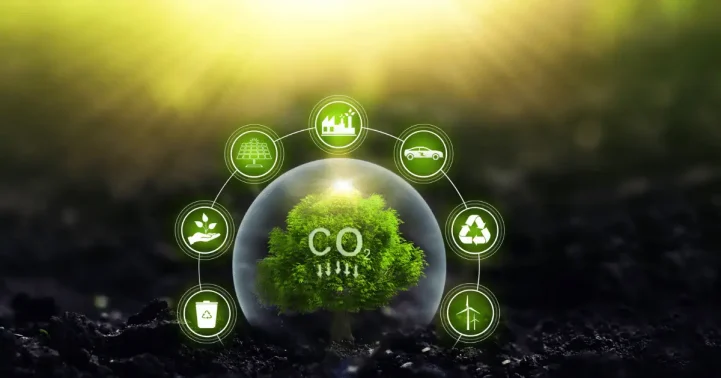The carbon removal industry could be worth $1.2 trillion by 2050, but only if it reaches the gigaton scale (a billion metric tons removed). According to the Intergovernmental Panel on Climate Change (IPCC), this is needed to reach global climate goals.
In addition, estimates from a report compiled by Smith School of Enterprise and the Environment’s, show that “six to ten gigatons of CO2 in annual CDR capacity would likely be needed by 2050 for most Paris-aligned net-zero pathways.”
The IPCC’s goals can be achieved through reforestation, enhanced weathering, and direct ocean capture.
Carbon removal for a net-zero future
Clearly, there’s a lot to be done over the next 26 years. McKinsey & Company researched 10 solutions to remove carbon from our atmosphere for a net-zero future.
Wetland and peatland restoration:
By restoring terrestrial wetlands and peatlands to absorb and store more CO2, the research team at McKinsey says it would increase biodiversity, improve water quality in the region, reduce flood risks, and boost eco-tourism.
Cropland, grassland, and agroforestry:
By improving and better managing cropland and grassland, the uptake of CO2 taken from the soil would be enhanced, along with removing CO2 from the atmosphere.
The benefits of doing this would improve biodiversity, enhance soil fertility and water retention, and increase agricultural productivity.
Reforestation and afforestation:
This involves planting trees in deforested regions, as well as areas where no trees had been planted before. It also includes the removal of atmospheric CO2, which strengthens the ecosystem’s resilience. A bonus benefit would be the boost to eco-tourism.
The other seven solutions identified by McKinsey include:
- Blue carbon management in oceans and coastal ecosystems.
- Biochar and bio-oil to improve soil quality.
- Ocean alkalinity enhancement to improve the ecosystem’s ability to absorb CO2 taken from the atmosphere.
- Enhanced weathering, where rocks and minerals are broken down to store carbon from the atmosphere.
- Bioenergy with carbon capture and storage to produce biofuels, electricity, and heat.
- Direct ocean capture to chemically extract CO2 from surface water for long-term storage.
- Direct air capture and storage to allow air to bind with CO2, stored in underground geological formations.
Carbon removal’s market potential
The financial benefits of implementing these solutions would be astronomical. McKinsey predicts that the industry capable of delivering gigaton-scale removals could be worth up to $1.2 trillion by 2050.
“With continued demand, investment, and innovation, TBR [technology-based removals] costs are estimated to decline by at least 30% and up to 60% through 2035, and continue to drop through 2050, albeit more slowly as the industry scales,” the report explains.
Carbon removal funding is currently estimated between $5 billion and $13 billion. Based on the projects already in development, McKinsey estimates that investment could reach between $100 billion and $400 billion by 2030.
“Although these are large amounts, this estimated investment is roughly five times lower than what would be needed by 2030 to be on track for net zero. Our estimates show $0.5 trillion to $2.0 trillion in cumulative investment would be needed by 2030 to provide the early traction necessary to put the industry on track to deliver the $6 trillion to $16 trillion of investment required by 2050.”
Challenges and opportunities
The environmental and financial benefits of carbon removal aside, the report highlights an important challenge. To achieve gigaton-scale removals within the next 26 years, a vast network of businesses and individuals must work together for the common good.
“This industry would require input and support from a range of players – including investors, suppliers, buyers, traders, and other intermediaries – with substantial potential value pools. These are long-term business opportunities that would require early action to build removal volumes to scale by 2050.”
Governments must “move early,” especially if they want to align with the Paris Agreement stipulations. If they do this, McKinsey says the carbon removal industry “could be a global opportunity” for everyone involved.
“A variety of solutions means countries could utilize those solutions best suited to their particular geographies. […] Supporting the [carbon removal industry] could provide governments with opportunities to promote skill development and job creation.”
Share this article
About the author
Cheryl has contributed to various international publications, with a fervor for data and technology. She explores the intersection of emerging tech trends with logistics, focusing on how digital innovations are reshaping industries on a global scale. When she's not dissecting the latest developments in AI-driven innovation and digital solutions, Cheryl can be found gaming, kickboxing, or navigating the novel niches of consumer gadgetry.













